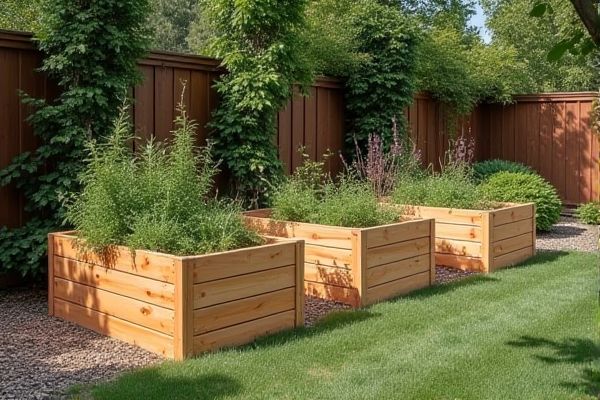
Cedar raised beds offer natural resistance to rot and insects, ensuring durability without chemical treatments, while pine beds tend to be more affordable but may require sealing to prevent decay. Explore the rest of the article to determine which option best suits your gardening needs and budget.
Table of Comparison
| Feature | Cedar Raised Beds | Pine Raised Beds |
|---|---|---|
| Durability | Highly durable; naturally rot-resistant for 10-15 years | Less durable; prone to decay without treatment, lasts 5-7 years |
| Cost | Higher price due to quality and longevity | More affordable, budget-friendly option |
| Toxicity | Non-toxic; safe for growing edibles | Generally safe, but treated pine may leach chemicals |
| Weight | Lighter; easier to handle and assemble | Heavier; denser wood but still manageable |
| Appearance | Attractive reddish-brown color, ages well | Light color; may require staining or painting |
| Maintenance | Low maintenance due to natural oils | Requires sealing or treatment to prolong life |
Introduction to Cedar vs Pine Raised Beds
Cedar raised beds offer natural resistance to rot and insects, making them a durable option for long-lasting garden structures. Pine raised beds, while more affordable, typically require treatment or sealing to prevent decay and extend their lifespan. Choosing between cedar and pine depends on your budget and the level of maintenance you're willing to commit to for your garden.
Comparing Wood Durability for Raised Beds
Cedar raised beds offer superior wood durability due to their natural resistance to rot, insects, and moisture, lasting approximately 15 to 20 years without treatment. Pine raised beds, while more affordable, typically have a shorter lifespan of around 5 to 10 years unless pressure-treated or sealed, which may introduce chemicals to your garden. Choosing cedar ensures a longer-lasting structure, reducing maintenance and replacement costs over time.
Cost Differences: Cedar vs Pine
Cedar raised beds typically cost more than pine due to cedar's natural resistance to rot and insects, offering greater durability and longevity. Pine is more budget-friendly upfront but may require replacement or treatment over time to withstand weather conditions. Choosing between cedar and pine involves balancing initial investment against long-term maintenance expenses and lifespan.
Natural Resistance to Rot and Pests
Cedar raised beds offer superior natural resistance to rot and pests due to their high content of natural oils and tannins, which act as preservatives. Pine, while more affordable, lacks this natural protection and often requires chemical treatment to prevent decay and insect damage. Choosing cedar ensures your raised bed will maintain structural integrity longer with less maintenance, benefiting your garden's longevity and health.
Maintenance Requirements: Cedar and Pine
Cedar raised beds demand minimal maintenance due to natural resistance to rot and insects, which extends their lifespan without frequent treatment. Pine raised beds require regular sealing or staining to prevent decay and insect damage, making upkeep more time-intensive. Choosing cedar can reduce your maintenance efforts and ensure longer-lasting garden structures.
Environmental Impact and Sustainability
Cedar raised beds offer a more sustainable choice due to their natural rot resistance, reducing the need for chemical preservatives and prolonging bed lifespan. Pine, often treated with chemicals to enhance durability, may introduce environmental pollutants and requires more frequent replacement, increasing waste. Choosing sustainably harvested cedar supports eco-friendly gardening by minimizing chemical use and enhancing long-term soil health.
Appearance and Aesthetic Considerations
Cedar raised beds feature a rich, reddish-brown hue that naturally weathers to a soft gray, enhancing garden aesthetics with a rustic yet polished look. Pine raised beds offer a lighter, more uniform color that complements bright, modern garden designs but may require staining or sealing to maintain appearance. Your choice affects the visual harmony of your garden space, balancing natural beauty with maintenance preferences.
Health and Safety: Untreated vs Treated Wood
Untreated cedar raised beds offer a natural resistance to rot and insects without the risk of harmful chemicals leaching into your soil, making them a safer choice for growing edible plants. Pine, often chemically treated to enhance durability, can pose potential health risks due to the possible transfer of toxic substances to your crops. Choosing untreated cedar ensures your garden remains free from harmful residues, promoting a healthier environment for your plants and your family.
Lifespan Expectancy: Cedar vs Pine Raised Beds
Cedar raised beds typically last 15 to 20 years due to their natural resistance to rot and insect damage, whereas pine beds generally last around 5 to 10 years unless treated with preservatives. Your choice of wood directly impacts the longevity and maintenance frequency of the garden structure. Opting for cedar can offer a longer-lasting investment with less frequent need for repair or replacement.
Choosing the Best Wood for Your Garden Needs
Cedar raised beds offer natural rot resistance and insect-repellent properties, extending garden bed longevity without chemical treatments. Pine raised beds are typically more affordable, allowing for larger or multiple boxes but may require regular sealing to prevent decay. Selecting cedar or pine depends on budget, desired durability, and maintenance commitment for optimal garden performance.
 homyna.com
homyna.com